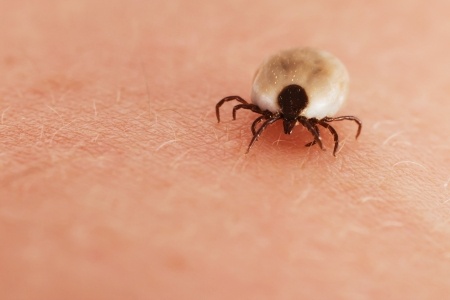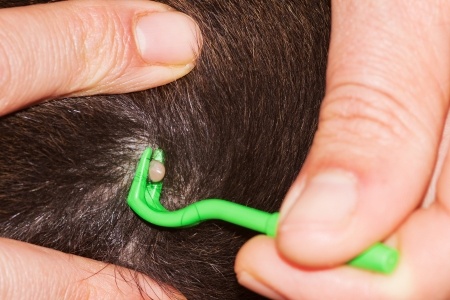Rockland County veterinarian, diagnosed with Lyme, learns lesson on Lyme awareness
Though I’ve heard lots of stories of people contracting Lyme disease, I never quite understood how a person could have a tick on him or her and not notice it. I always teach clients that ticks can attach to their pets and go undetected for days, but on a person? How do you miss that??? Then one day, I woke up with a strange rash on my chest…
Didn’t Have the Classic Symptoms
When I first noticed it, I assumed it was a minor allergic reaction and dismissed it. I applied a bit of cortisone cream and thought that would put an end to the whole thing. Still, the redness persisted another three days, so I went to my family physician. To my slack-jawed amazement, the doctor diagnosed me with Lyme disease.
But how could this be possible? I hadn’t had a tick on me, had I? I was so convinced that he was wrong (and I was right!), that I sought out two more opinions, one from a dermatologist and another from an infectious disease specialist in the Rockland County Hospital emergency room. Each agreed with my family physician’s initial diagnosis. I had Lyme!
Lyme Disease in Dogs (and People!) is a Real Threat
It’s been a humbling experience. How many times have I tried to convince my clients that tick prevention is essential? That a tick bite can come and go with no one the wiser? Yet, my own doctor diagnosed me with one of the Northeast’s most notorious illnesses and I dismissed him. Oh veterinarian heal thyself!
Here is a link to a VERY eye opening map of Lyme disease across the US
Life Cycle of a Tick
If bugs give you the willies, then you might want to skip past the life cycle of ticks. Ixodes Scapularis, the bloodsucker responsible for spreading Lyme disease in New York, takes two years to complete its life cycle. Females lay eggs, the offspring from which climb to the tips of grass blades where they hitch a ride on field mice, in particular, the White Footed Deer Mouse. Here they enjoy their first taste of blood and here they become infected with the organism responsible for transmitting Lyme disease, Borrelia burgdorferi.
Approximately 72 hours after feeding, larva drop from the mouse, find a protected site and molt into the nymph stage. They remain inactive till the following summer.
Nymphal ticks are only the size of a pin head and show little preference for where they’ll take their next feeding of blood. Ticks at this stage of development are the hardest to see, the hardest to feel when they are on you, and the most infectious.
After this second meal, the ticks again drop off into the environment, molt once more, and emerge as adult ticks in the fall. This is the stage that shows a preference for feeding on deer (hence the name Deer Tick) as well as a host of other mammals including humans and dogs. While the male tick only intermittently feeds, the adult female feeds for 3-5 days. She consumes enough blood to support her prodigious production of up to 3000 eggs!
Why Is Year Round Tick Prevention Important?
Though ticks are mostly dormant in the fall and winter, it’s important to point out that ticks feed whenever the ambient temperature is above freezing, meaning that transmission of Lyme disease can happen 12 months out of any year. At Animal Medical, we’ve removed ticks from dogs during snowstorms.
Contracting Lyme Disease has been a sobering experience for me on many levels, but it’s an experience that I’m determined to turn into something positive for my clients and patients. Animal Medical has excellent, safe, medications that both repel and kill ticks and a vaccine that is very good at stopping Lyme disease if ticks get past the preventative line of defense. The next time you’re in, either my staff or I will talk to you teach you more on the subject.
As for me, I’ll be fine. I have finished a course of antibiotics and am scheduled for a follow up visit with my doctor to confirm that I am completely cured. It’s been a relatively easy, but frightening lesson on the value of keeping ticks at bay.




